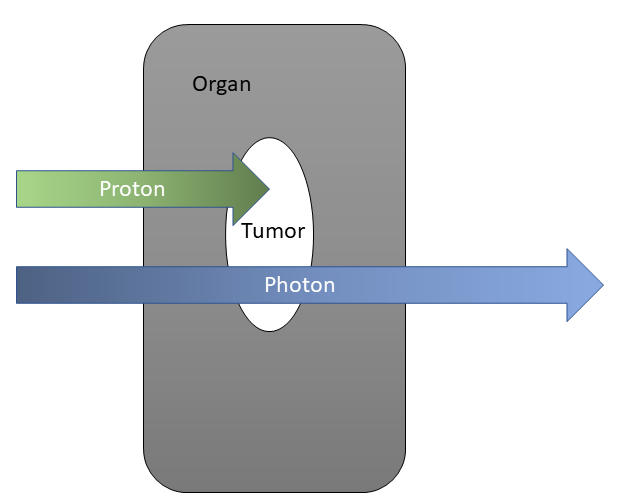I saw the recent news saying that Singapore would be opening 2 proton beam therapy centre, one in NCCS and another at Mount Elizabeth Novena. Coincidentally, both are the places I intern at. This is the first time I ever heard of the therapy though. Apparently, the machines are very expensive (I’m talking $100 million) which means I’m expecting the therapy to be fucking expensive too.
It’s expensive to extend your lifespan.
According to Verma et al, 2016, proton beam therapy might not be the most cost-effective method. In fact, it does not work for many types of cancer too. So exactly what kind of cancer is best treated with proton beam therapy?
How it works?
Radiation therapy is commonly used for cancer treatment. Photon therapy (aka X-ray) is used most commonly, but proton therapy is said to have an advantage over photon therapy.

As seen in figure 1, photon enters the organ in high dose, hits the tumour and exit with a lower dose. On the other hand, proton enters the organ at a lower dose, hitting the tumour with the highest dose of radiation and stops.¹
Radiation causes DNA double-strand breakage in cells which can kill a cell, but it can also damage healthy cells.² Exposing healthy cells to lesser radiation reduces complication due to treatment. Since proton enters the body at a lower dose initially, it is possible to give a higher dose of radiation to patients in one treatment compared to photon therapy. This reduces chances of recurrence and lowers the risk of damaging healthy organs.¹
In addition, compared to neutron therapy in which severe toxicity was reported, there had been no reported severe side effects that occur from proton therapy.²
However, similar to photon therapy, proton therapy only works on solid tumour, which means that cancer like leukaemia would not benefit from this therapy.
Who is it good for?
Proton beam therapy would work best if the tumour is near to the skin surface because lesser healthy cells would be affected. It would also have a benefit if the tumour is situated near an important organ. Young children with cancer should also consider proton beam therapy since it reduces the number of healthy cells exposed to radiation, thus reducing damage and lessening the risk of long-term effects.
| Type of radiation therapy | Risk of secondary lethal cancer |
| Conventional photon therapy | 0.198 (19.8%) |
| Intensity modulated x-ray therapy | 0.303 (30.3%) |
| Conventional electron therapy | 0.210 (21.0%) |
| Intensity/energy modulated electron therapy | 0.149 (14.9%) |
| Proton therapy | 0.034 (3.4%) |
Table 1: The data shows the risk of secondary lethal cancer after receiving various forms of radiation for childhood medulloblastoma³
As seen in table 1, proton therapy reduces the risk of patients developing secondary cancer due to radiation exposure to healthy cells.
Effects on the different type of cancer
Although proton beam therapy would damage lesser healthy cells, it does not always produce clinical benefits. However, there are evidences that it is effective for pediatric cancer and brain.²
Pediatric cancer
Proton beam therapy causes lesser damage to healthy cells and lowers the risk of secondary cancer. Compared to photon therapy, there are lesser negative side effects to cognitive (learning) and endocrine (hormones) functions which allow the patient to have a better quality of life after treatment.²
Medulloblastoma
For medulloblastoma treatment, radiation had to be given to the brain and spine. If treated with photon therapy, structures around the brain and spine would receive radiation dose during treatment. However, proton therapy reduces the radiation exposure to nearby structures. It had been reported that proton therapy reduces acute toxicity for adult patients, and reduces secondary cancer risks for children.²
Brain cancer
Surgery for brain cancer often could not fully remove all the cancerous cells due to the sensitivity of the brain. Proton therapy could be used after surgery to reduce the recurrence of cancer.² Especially since the brain is a sensitive organ, photon therapy might cause more damages during treatment.
Uveal melanoma (eye) and ocular melanoma
There had been thousands of uveal melanoma patients that received proton treatment and was reported to have high control rate (>95% 5-year survival rate) and high eye preservation rate (>90%).² This makes it a really good treatment option for uveal melanoma.
When ocular melanoma could not be treated by brachytherapy, proton beam therapy is a good alternative. It is now studied to compare whether brachytherapy or proton beam therapy would be better for the patients.4
Lung cancer
For later stages of lung cancers, proton beam therapy causes lesser damage to lung volume compared to photon therapy. There had been no reported benefits for using proton beam therapy over photon therapy for early-stage lung cancer.4
However, a challenge in using proton beam therapy for lung cancer is that the tumour moves when you breathe, thus it requires more planning works and have may lower accuracy.4
Prostate cancer
Prostate cancer has the highest number of patients treated with proton beam therapy. However, data had shown that while proton beam therapy can be used as a treatment option, there had been no reported significant benefit over photon therapy.4
Head and neck cancer
Treatment for head and neck cancer by photon therapy can cause death due to damage to healthy tissues. Many of the patients suffered from toxicity from the radiation. Critical structures such as spinal cord around the tumour may be small in size and thus easily damaged by a small dose of radiation.4
While proton beam therapy had been shown to be useful for the treatment of tumours near critical structures, there are not enough data to recommend proton beam therapy as routine radiation therapy for patients.4
Cost
| Treatment | Lifetime Costs |
| Brachytherapy | $29,575 |
| Intensity-modulated radiation therapy | $41,591 |
| Proton Beam Therapy | $72,789 |
Table 2: Comparison of lifetime costs between brachytherapy, intensity-modulated radiation therapy and proton beam therapy5
This shows that proton beam therapy is not cheap. Even though it had been shown to have advantages for certain cancer type, does it really justify the higher price tag?
The news claimed that NHS had sent patients for proton beam therapy in 2016, with a high average cost of £114 thousand. I am not sure if it would be covered by insurance or Medisave/Medishield but this is definitely not cheap. “Last year, the NHS sent 210 patients abroad for PBT – mostly to the US and Switzerland – at a cost of about £114,000 each.”
Are cancer treatments always that expensive? What happens to patients with lower income? Will they get denied treatment?
This is something we have to tackle.
References:
5. Ollendorf, D., Hayes, J., McMahon, P., Pearson, S., Kuba, M. and Tramontano, A. (2008). Brachytherapy and Proton Beam Therapy for Treatment of Clinically Localized, Low-Risk Prostate Cancer. [ebook] Institute for Clinical and Economic Review Final Appraisal Document. Available at: http://www.nomos.com/pdf/ICER.pdf [Accessed 14 May 2018].






